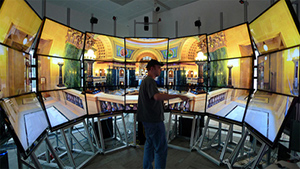"NexCAVE exploration of Jordan archaeological excavation site. Speaker: Tom Levy, Professor, UCSD and Associate Director, CISA3."-YouTube description
NexCave Demo 3 of Wind Patterns, with 3D sound and HD monitors.
NexCave Display of 3D Model of Calit2 at UC San Diego
RELATED
JVC Introduces the NexCAVE System
"JVC’s Professional Products division is proud to announce today that the California Institute for Telecommunications and Information Technology has developed a new immersive visualization system they call the NexCAVE. This device uses nine GD-463D10U 3D HD monitors to give the user the feeling that they are in the environment. All of these displays feature a 46” diagonal screen, full HD (1920 x 1080) resolution, and 2000:1 contrast ratio. The NexCAVE is created by the same developers who created the CAVE system, which uses 3D projectors to turn a room into a 3D environment. The use of monitors instead of projectors allows for a more compact system that can also be portable for traveling purposes. Unfortunately their isn’t any word when the NexCAVE will be released at this time." -HDTV Review 11/24/09 (Via ITVT)
University of California's Calit2 Develops Immersive 3D Visualization System Using JVC Monitors -Tracy Swedlow, InteractiveTV Today 11/24/09
"Calit2 research scientist, Tom DeFanti, and his partner, Dan Sandin, began designing visualization systems over 35 years ago when they co-founded the Electronic Visualization Laboratory at the University of Illinois at Chicago. According to DeFanti, back in 1991 the pair conceived of the original CAVE system using projectors to reconstruct a 3D surround environment. According to JVC, early projector-based virtual reality (VR) systems were generally limited by two major problems: resolution was "fair at best," due to limitations in computer processing power and projector technology; and the systems required a very large dedicated space--since users could block images projected by front projectors, rear projectors, which required sufficient throw distance, were necessary."
-Tiffany Fox, US SanDiego News Center 8/17/09
-Doug Ramsey, UC San Diego News Center 9/25/09
I like the pictures. In addition to use for visualization, this system might be a great platform for interactive multimedia art installations!
I like the pictures. In addition to use for visualization, this system might be a great platform for interactive multimedia art installations!



No comments:
Post a Comment